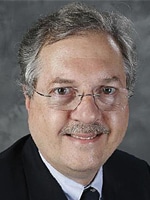Meredith W. Salisbury
August 2020—As the need for COVID-19 testing grows well beyond that for hospital patients, clinical laboratories in mid-summer were again overwhelmed by demand while at the same time bracing for flu season.
That was the gist of a July 10 webinar that brought together Gyorgy Abel, MD, PhD, medical director of clinical chemistry, molecular diagnostics, immunology, and point-of-care testing at Lahey Hospital and Medical Center, Burlington, Mass.; Bob McGonnagle, CAP TODAY publisher; and moderator Steve Beuchaw, director of life science and medical device research, Wolfe Research.
Demand for COVID-19 testing appeared to be nearly insatiable as several states were breaking records for daily case numbers and death rates were beginning to climb after two months of decline. “The headline for the last couple of weeks would be the enormous demand for molecular PCR testing for the definitive diagnosis of COVID,” McGonnagle said. “At the moment it’s really overwhelming laboratory capacity.”

Dr. Abel
Adding to the difficulty is that the testing capacity that’s needed is “a moving target,” Dr. Abel said. As testing expands to new populations—asymptomatic patients, college students, entire workforces—even recent capacity increases have proved insufficient. Manufacturers are responding by releasing more tests for SARS-CoV-2 on a broad range of diagnostic platforms, and new large laboratories are being built to scale up capacity quickly.
Also increasing the need for COVID-19 testing is the return of elective surgeries. Given how many procedures were deferred during lockdowns or by patients too worried about the pandemic to seek care, a resumption could push the demand further for SARS-CoV-2 testing. McGonnagle and Dr. Abel agree that clinical labs in the U.S. would have to increase capacity to at least 6 million tests per week to meet acute care needs.
Beuchaw calls test manufacturers’ response to the pandemic “extraordinary,” and he wonders how much more it is possible for them to continue increasing supplies of tests and reagents. “They have every incentive to fulfill that need,” McGonnagle said, noting that current bottlenecks were caused not only by instrument or kit shortages but also by limitations in lab resources.
Most clinical laboratories have been successful in redirecting or hiring medical technologists to shift resources to COVID-19 testing, Dr. Abel said. And labs addressed test supply problems largely by implementing SARS-CoV-2 testing on more than one platform. Labs need to use all options, he said, even manual testing, to increase capacity.
The varying capabilities of clinical laboratories present a big challenge, McGonnagle said. “The labs that can do COVID PCR testing across the United States number probably no more than 1,000,” and test demand has largely flowed upward from system laboratories to regional, national, reference, and large commercial labs. “All are dealing with test demand that has strained the system and hugely lengthened turnaround times,” he said.
Despite these difficulties, McGonnagle and Dr. Abel say, capacity could be increased substantially within just four to five weeks, in part by laboratories bringing back their furloughed staff.
In addition, they say, new technologies have become available that could expand testing capacity, but they don’t expect them to become widely used in clinical laboratories.
Assays based on next-generation sequencing or mass spectrometry (PCR plus MALDI-TOF) technologies might make it possible to run thousands of samples at a time, but the underlying platforms tend to be expensive and the required preanalytical work is extensive, Dr. Abel said. For labs that already have high-end next-gen sequencers or MALDI-TOF mass spectrometry instruments up and running, though, these assays could be viable options for increasing capacity for SARS-CoV-2 testing. Next-generation sequencers, for instance, can run nearly 4,000 tests in a 12-hour shift, Dr. Abel said, pointing out that sequencer manufacturers might consider this application attractive enough to invest in placing their machines in clinical labs. “There will be some interest in the market for this,” he predicts.
McGonnagle said the nightmare scenario is that COVID-19 will be rampant when flu season hits: “If it becomes a severe flu season, the diagnostic dilemma is going to be just incredible.”
When the pandemic began in this country, Dr. Abel said, many laboratories were still running tests for the end of the last flu season. At the time, some were required to test first for influenza and to move on to COVID-19 testing only if the flu results were negative. As flu season wound down, that approach was abandoned. But for the upcoming flu season, laboratory teams will have to prepare to test for both pathogens, or establish an algorithm to determine the sequence of tests to use. If there is still a need for large-scale COVID-19 testing when flu season begins, a rapid multiplex test covering both influenza and SARS-CoV-2 would make sense for many labs, and these kinds of tests should be ready in time for flu season, Dr. Abel said. “The viable multiplex provider is going to be a big winner here,” McGonnagle added.
Dr. Abel considered some of the latest research in COVID-19 immunity for a look at what could become important for clinical testing in the future.
Recent studies suggest that testing for T cells, for instance, might offer insight into a patient’s immune response to SARS-CoV-2 infection. “T helper cells that recognize the SARS-CoV-2 spike protein can play a very important role in immunity,” Dr. Abel said. Studies published in Cell and Nature have demonstrated that some people have T cells able to recognize protein antigens from the new coronavirus despite their never having been exposed to SARS, MERS, or COVID-19. “This is probably due to cross-reactivity with proteins from common coronaviruses,” he said. “There might be a part of the population that has some preexisting immunity against COVID-19.” Spotting these T cells in a patient might be useful in diagnostics as well as in vaccine development.
“The problem is that this is really pure research at this point,” he said, adding, “There is a significant knowledge gap in our understanding of the T cell response.”
Meredith Salisbury is a writer in the New York City area.